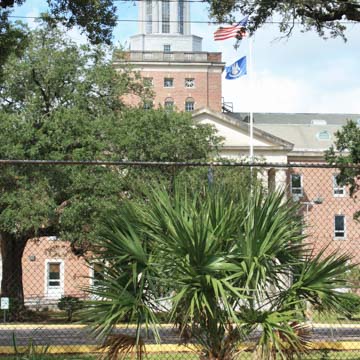Surrounded by a c. 1895 high brick wall, this 17.2-acre site now occupied by the Children’s Hospital has a long and illustrious history. Initially consisting of plantations, including that of Jean Etienne de Boré, the location later accommodated a sawmill and a brickworks. A cottage dating from the 1830s remains. In 1883, the land was sold to the U.S. government, which built a hospital, known as the Marine Hospital, to serve merchant seaman and local armed forces. The two-story galleried building known as the Director’s House (c. 1885) belongs to this period. By the late 1920s, severe overcrowding in the existing buildings led to a construction campaign that resulted in a new hospital, the five-story Greek Revival brick Main Building, which features a monumental pedimented entrance portico and is crowned with an octagonal cupola (lit at night). In the early 1930s, landscape architect Albert D. Taylor of Ohio prepared a new site plan and the entire complex was substantially rebuilt with two-story red brick buildings that harmonized with the Main Building. The complex closed in 1981 and the federal government donated the buildings to the State of Louisiana, which used them as a psychiatric hospital for adolescents; the State closed the hospital in 2009 as a cost-saving measure. In 2014, Children’s Hospital purchased the site, which is across Henry Clay from its existing facility. The Main Building will be used for office space and most of the support buildings constructed in the 1930s will be retained for the Childrens Hospital’s administrative needs, including a conference center. The brick buildings are surrounded by ancient oak trees, which add to the beauty and tranquility of the site.
You are here
Children’s Hospital (U.S. Public Service [Marine] Hospital)
1830s and later; 1928 Main Building, James A. Wetmore, Supervising Architect of the U.S. Treasury; c. 1930 site plan, A. D. Taylor, landscape architect; 1931–1932; 2014–present, Eskew+Dumez+Ripple, with FKP Architects. Tchoupitoulas St. at Henry Clay Ave.
If SAH Archipedia has been useful to you, please consider supporting it.
SAH Archipedia tells the story of the United States through its buildings, landscapes, and cities. This freely available resource empowers the public with authoritative knowledge that deepens their understanding and appreciation of the built environment. But the Society of Architectural Historians, which created SAH Archipedia with University of Virginia Press, needs your support to maintain the high-caliber research, writing, photography, cartography, editing, design, and programming that make SAH Archipedia a trusted online resource available to all who value the history of place, heritage tourism, and learning.


